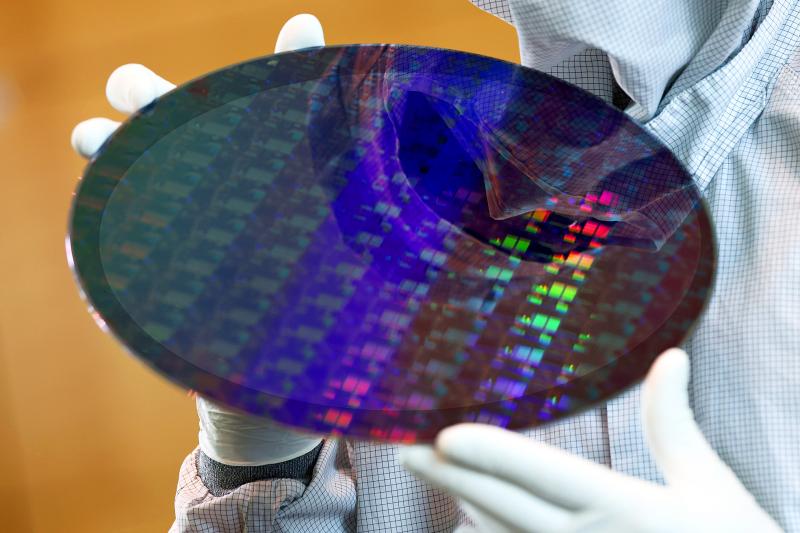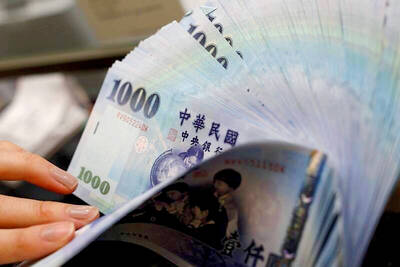The production value in Taiwan’s semiconductor industry this year is expected to soar 31.8 percent from last year to NT$3.6 trillion (US$129 billion), outpacing 10.1 percent growth in the global semiconductor industry, market researcher the Market Intelligence and Consulting Institute (產業情報研究所) said yesterday.
The Taipei-based researcher attributed the strong outlook for the local semiconductor industry to demand for chips used in notebook computers amid a COVID-19 pandemic-induced stay-at-home economy, as well as emerging applications from 5G and artificial intelligence to automotive electronics.
Production in the foundry segment, a pillar of Taiwan’s semiconductor industry, is to expand 20 percent annually to NT$1.9 trillion, driven by higher chip prices as demand continues to outstrip supply, the institute said.

Photo: Bloomberg
Chipmakers would increase prices, passing on increases in manufacturing costs, it said.
“Semiconductor shortages have become a new global norm,” said Cheng Kai-an (鄭凱安), a senior industry analyst at the institute.
“It has become a new business model for foundry companies to ink long-term supply agreements and collect prepayments,” Cheng said in a statement. “Foundry companies are raising prices to reflect higher costs and to boost gross margin. Hiking chip prices will also help avert overbooking, which could lead to supply-demand imbalance.”
For suppliers of DRAM and flash memory chips, prices are to peak in the second half of this year, leaving little room for further upticks, he said.
Taiwan Semiconductor Manufacturing Co (TSMC, 台積電), the world’s biggest foundry service provider, said that it expects its revenue to expand more than 20 percent this year from last year.
TSMC has reportedly raised prices by 10 to 20 percent for new orders.
Local chip testing and packaging service providers are to increase product value by 25 percent this year from last year, benefiting from strong demand, price increases and supply constraints, the institute said.
On top of that, some local companies are to receive orders transferred from peers, as some plants were forced to halt production due to COVID-19 restrictions in Malaysia, the market researcher said.
Chip designers, led by MediaTek Inc (聯發科), are expected to report growth of 33 percent year-on-year this year to cross the NT$1 trillion mark for the first time, to NT$1.1 trillion, it said.
Demand is rising for a wide range of chips, helping to propel revenue growth, Cheng said.
However, supply of microcontroller units, power management ICs and radio frequency ICs might remain tight due to a capacity squeeze at foundries, he said.
The institute said that it expects a global chip crunch to continue next year and in 2023, as it takes time for chipmakers to ramp up new production and for governments to build local supply chains.
Over the next three years, the compound annual growth rate of production value in Taiwan’s foundry sector is expected to be 10.5 percent, it said.
Chip designers and memorychip makers are expected to grow 7.9 percent and 7.5 percent respectively, while chip testers and packagers would expand 7.2 percent, it said.

Merida Industry Co (美利達) has seen signs of recovery in the US and European markets this year, as customers are gradually depleting their inventories, the bicycle maker told shareholders yesterday. Given robust growth in new orders at its Taiwanese factory, coupled with its subsidiaries’ improving performance, Merida said it remains confident about the bicycle market’s prospects and expects steady growth in its core business this year. CAUTION ON CHINA However, the company must handle the Chinese market with great caution, as sales of road bikes there have declined significantly, affecting its revenue and profitability, Merida said in a statement, adding that it would

MARKET LEADERSHIP: Investors are flocking to Nvidia, drawn by the company’s long-term fundamntals, dominant position in the AI sector, and pricing and margin power Two years after Nvidia Corp made history by becoming the first chipmaker to achieve a US$1 trillion market capitalization, an even more remarkable milestone is within its grasp: becoming the first company to reach US$4 trillion. After the emergence of China’s DeepSeek (深度求索) sent the stock plunging earlier this year and stoked concerns that outlays on artificial intelligence (AI) infrastructure were set to slow, Nvidia shares have rallied back to a record. The company’s biggest customers remain full steam ahead on spending, much of which is flowing to its computing systems. Microsoft Corp, Meta Platforms Inc, Amazon.com Inc and Alphabet Inc are

RISING: Strong exports, and life insurance companies’ efforts to manage currency risks indicates the NT dollar would eventually pass the 29 level, an expert said The New Taiwan dollar yesterday rallied to its strongest in three years amid inflows to the nation’s stock market and broad-based weakness in the US dollar. Exporter sales of the US currency and a repatriation of funds from local asset managers also played a role, said two traders, who asked not to be identified as they were not authorized to speak publicly. State-owned banks were seen buying the greenback yesterday, but only at a moderate scale, the traders said. The local currency gained 0.77 percent, outperforming almost all of its Asian peers, to close at NT$29.165 per US dollar in Taipei trading yesterday. The

The US overtaking China as Taiwan’s top export destination could boost industrial development and wage growth, given the US is a high-income economy, an economist said yesterday. However, Taiwan still needs to diversify its export markets due to the unpredictability of US President Donald Trump’s administration, said Chiou Jiunn-rong (邱俊榮), an economics professor at National Central University. Taiwan’s exports soared to a record US$51.74 billion last month, driven by strong demand for artificial intelligence (AI) products and continued orders, with information and communication technology (ICT) and audio/video products leading all sectors. The US reclaimed its position as Taiwan’s top export market, accounting for